Poverty and Crime: Disciplinary Explanations and Arguments
VerifiedAdded on 2021/02/20
|8
|2710
|282
Report
AI Summary
This report delves into the intricate relationship between poverty and crime, examining it from two distinct disciplinary perspectives. The report begins by outlining the connection between poverty and crime, drawing on insights from sociology and economics. It then compares and contrasts the explanations offered by each discipline, highlighting key differences in their approaches. One perspective emphasizes factors like lack of education, price hikes, and inadequate health provisions as primary drivers of crime, while the other points to income inequality and social and economic policies. The report further analyzes the arguments, assessing the merits of each disciplinary approach. The report concludes by arguing which perspective offers a more effective explanation, considering the research methodologies and data analysis. Overall, the report provides a comprehensive understanding of the complex interplay between poverty and crime, offering valuable insights into potential solutions and policy implications.
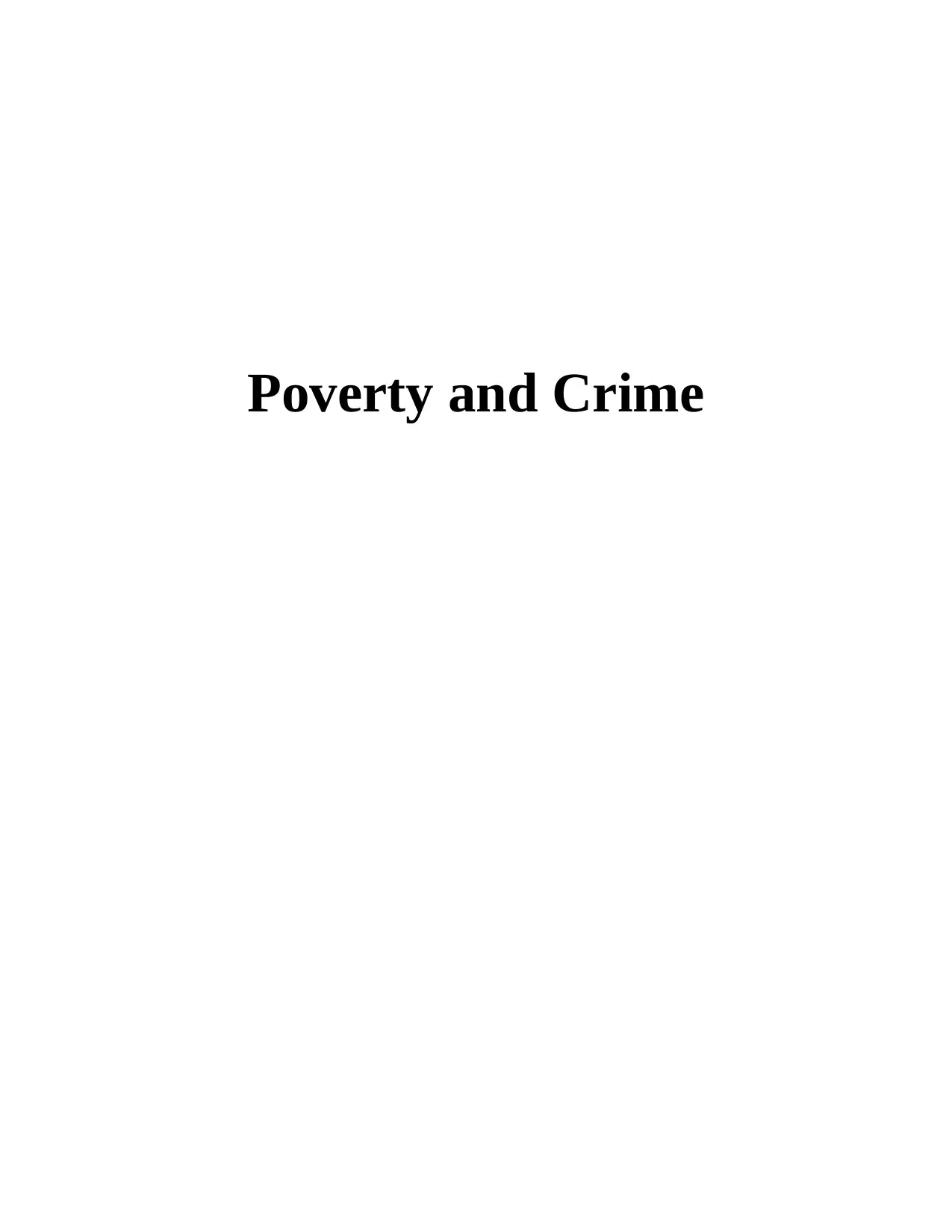
Poverty and Crime
Paraphrase This Document
Need a fresh take? Get an instant paraphrase of this document with our AI Paraphraser
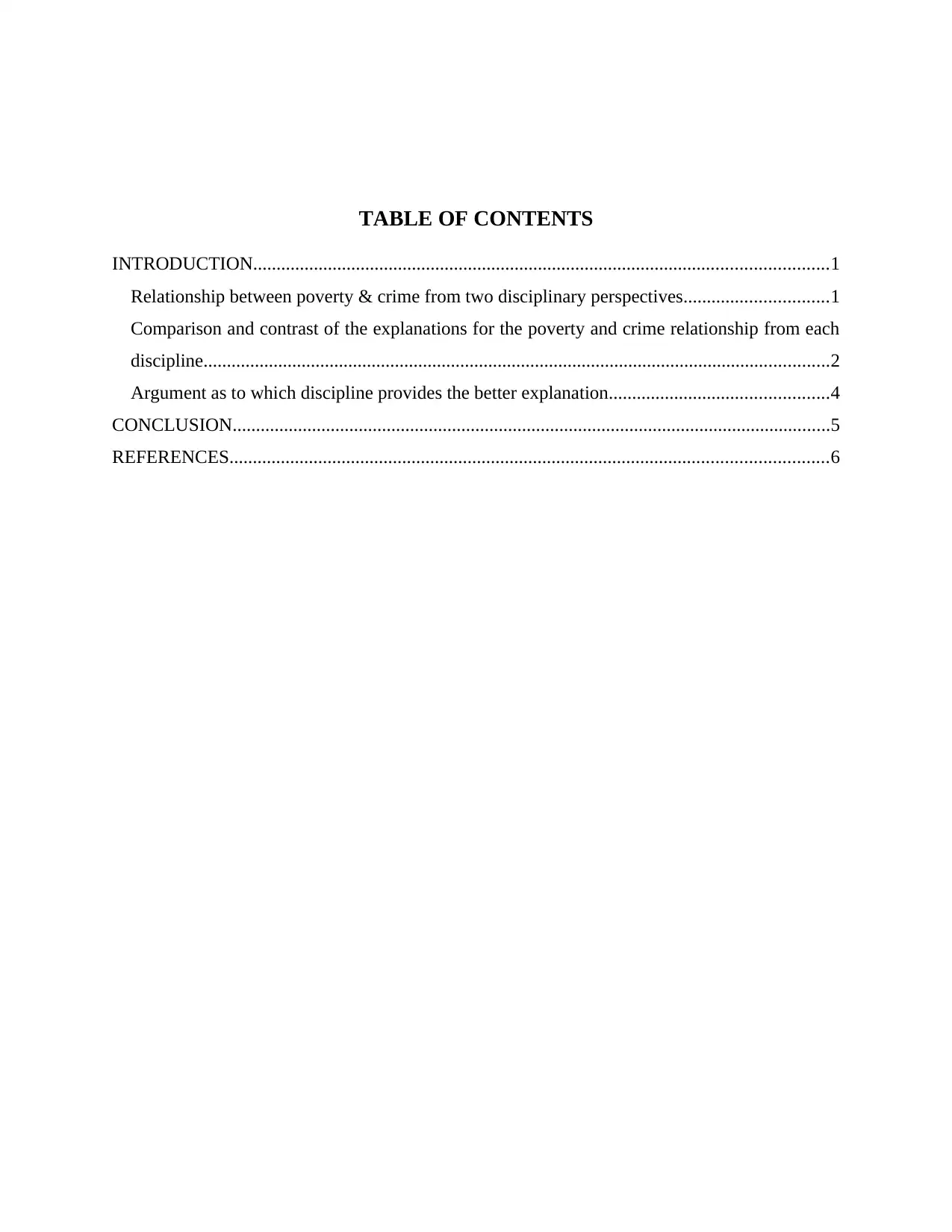
TABLE OF CONTENTS
INTRODUCTION...........................................................................................................................1
Relationship between poverty & crime from two disciplinary perspectives...............................1
Comparison and contrast of the explanations for the poverty and crime relationship from each
discipline......................................................................................................................................2
Argument as to which discipline provides the better explanation...............................................4
CONCLUSION................................................................................................................................5
REFERENCES................................................................................................................................6
INTRODUCTION...........................................................................................................................1
Relationship between poverty & crime from two disciplinary perspectives...............................1
Comparison and contrast of the explanations for the poverty and crime relationship from each
discipline......................................................................................................................................2
Argument as to which discipline provides the better explanation...............................................4
CONCLUSION................................................................................................................................5
REFERENCES................................................................................................................................6
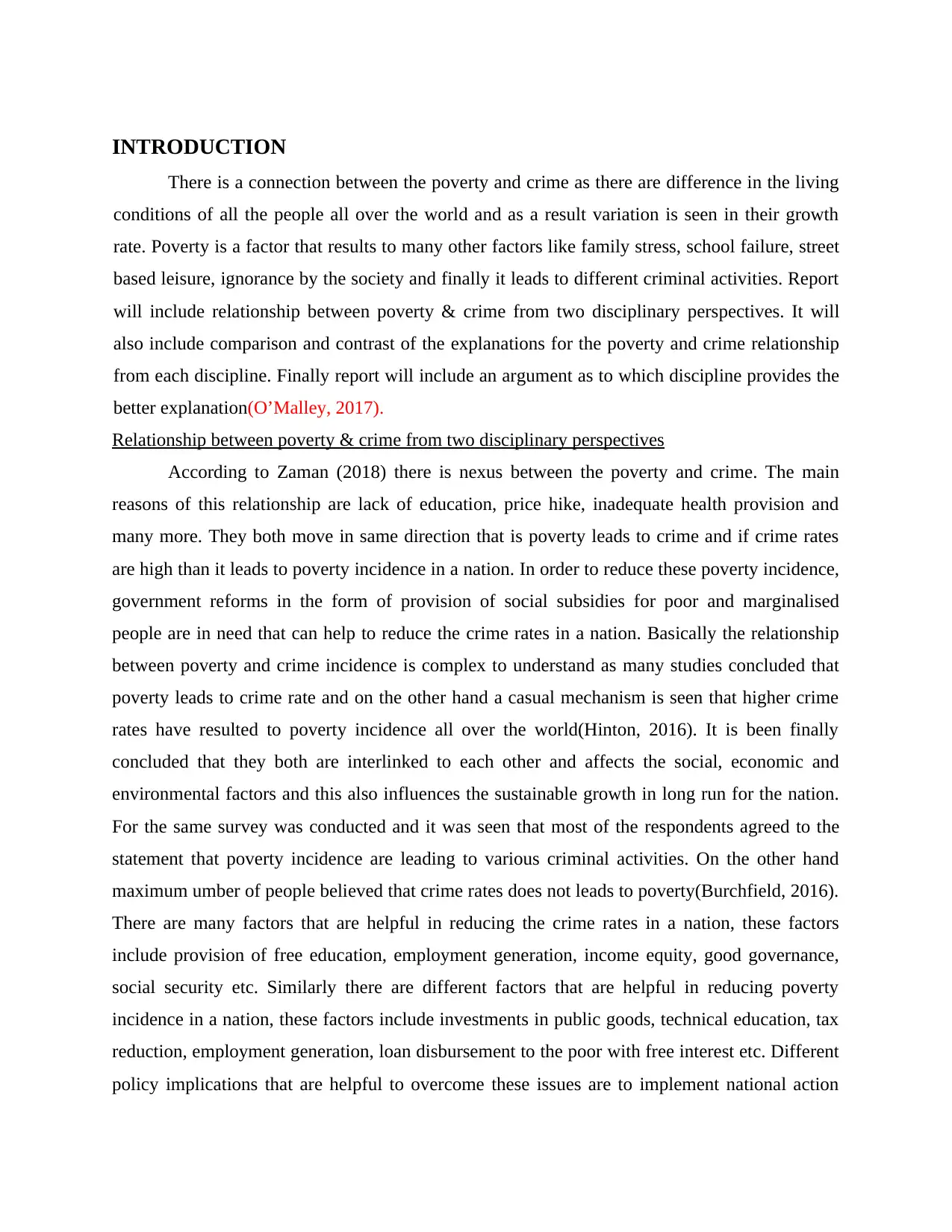
INTRODUCTION
There is a connection between the poverty and crime as there are difference in the living
conditions of all the people all over the world and as a result variation is seen in their growth
rate. Poverty is a factor that results to many other factors like family stress, school failure, street
based leisure, ignorance by the society and finally it leads to different criminal activities. Report
will include relationship between poverty & crime from two disciplinary perspectives. It will
also include comparison and contrast of the explanations for the poverty and crime relationship
from each discipline. Finally report will include an argument as to which discipline provides the
better explanation(O’Malley, 2017).
Relationship between poverty & crime from two disciplinary perspectives
According to Zaman (2018) there is nexus between the poverty and crime. The main
reasons of this relationship are lack of education, price hike, inadequate health provision and
many more. They both move in same direction that is poverty leads to crime and if crime rates
are high than it leads to poverty incidence in a nation. In order to reduce these poverty incidence,
government reforms in the form of provision of social subsidies for poor and marginalised
people are in need that can help to reduce the crime rates in a nation. Basically the relationship
between poverty and crime incidence is complex to understand as many studies concluded that
poverty leads to crime rate and on the other hand a casual mechanism is seen that higher crime
rates have resulted to poverty incidence all over the world(Hinton, 2016). It is been finally
concluded that they both are interlinked to each other and affects the social, economic and
environmental factors and this also influences the sustainable growth in long run for the nation.
For the same survey was conducted and it was seen that most of the respondents agreed to the
statement that poverty incidence are leading to various criminal activities. On the other hand
maximum umber of people believed that crime rates does not leads to poverty(Burchfield, 2016).
There are many factors that are helpful in reducing the crime rates in a nation, these factors
include provision of free education, employment generation, income equity, good governance,
social security etc. Similarly there are different factors that are helpful in reducing poverty
incidence in a nation, these factors include investments in public goods, technical education, tax
reduction, employment generation, loan disbursement to the poor with free interest etc. Different
policy implications that are helpful to overcome these issues are to implement national action
There is a connection between the poverty and crime as there are difference in the living
conditions of all the people all over the world and as a result variation is seen in their growth
rate. Poverty is a factor that results to many other factors like family stress, school failure, street
based leisure, ignorance by the society and finally it leads to different criminal activities. Report
will include relationship between poverty & crime from two disciplinary perspectives. It will
also include comparison and contrast of the explanations for the poverty and crime relationship
from each discipline. Finally report will include an argument as to which discipline provides the
better explanation(O’Malley, 2017).
Relationship between poverty & crime from two disciplinary perspectives
According to Zaman (2018) there is nexus between the poverty and crime. The main
reasons of this relationship are lack of education, price hike, inadequate health provision and
many more. They both move in same direction that is poverty leads to crime and if crime rates
are high than it leads to poverty incidence in a nation. In order to reduce these poverty incidence,
government reforms in the form of provision of social subsidies for poor and marginalised
people are in need that can help to reduce the crime rates in a nation. Basically the relationship
between poverty and crime incidence is complex to understand as many studies concluded that
poverty leads to crime rate and on the other hand a casual mechanism is seen that higher crime
rates have resulted to poverty incidence all over the world(Hinton, 2016). It is been finally
concluded that they both are interlinked to each other and affects the social, economic and
environmental factors and this also influences the sustainable growth in long run for the nation.
For the same survey was conducted and it was seen that most of the respondents agreed to the
statement that poverty incidence are leading to various criminal activities. On the other hand
maximum umber of people believed that crime rates does not leads to poverty(Burchfield, 2016).
There are many factors that are helpful in reducing the crime rates in a nation, these factors
include provision of free education, employment generation, income equity, good governance,
social security etc. Similarly there are different factors that are helpful in reducing poverty
incidence in a nation, these factors include investments in public goods, technical education, tax
reduction, employment generation, loan disbursement to the poor with free interest etc. Different
policy implications that are helpful to overcome these issues are to implement national action
⊘ This is a preview!⊘
Do you want full access?
Subscribe today to unlock all pages.

Trusted by 1+ million students worldwide
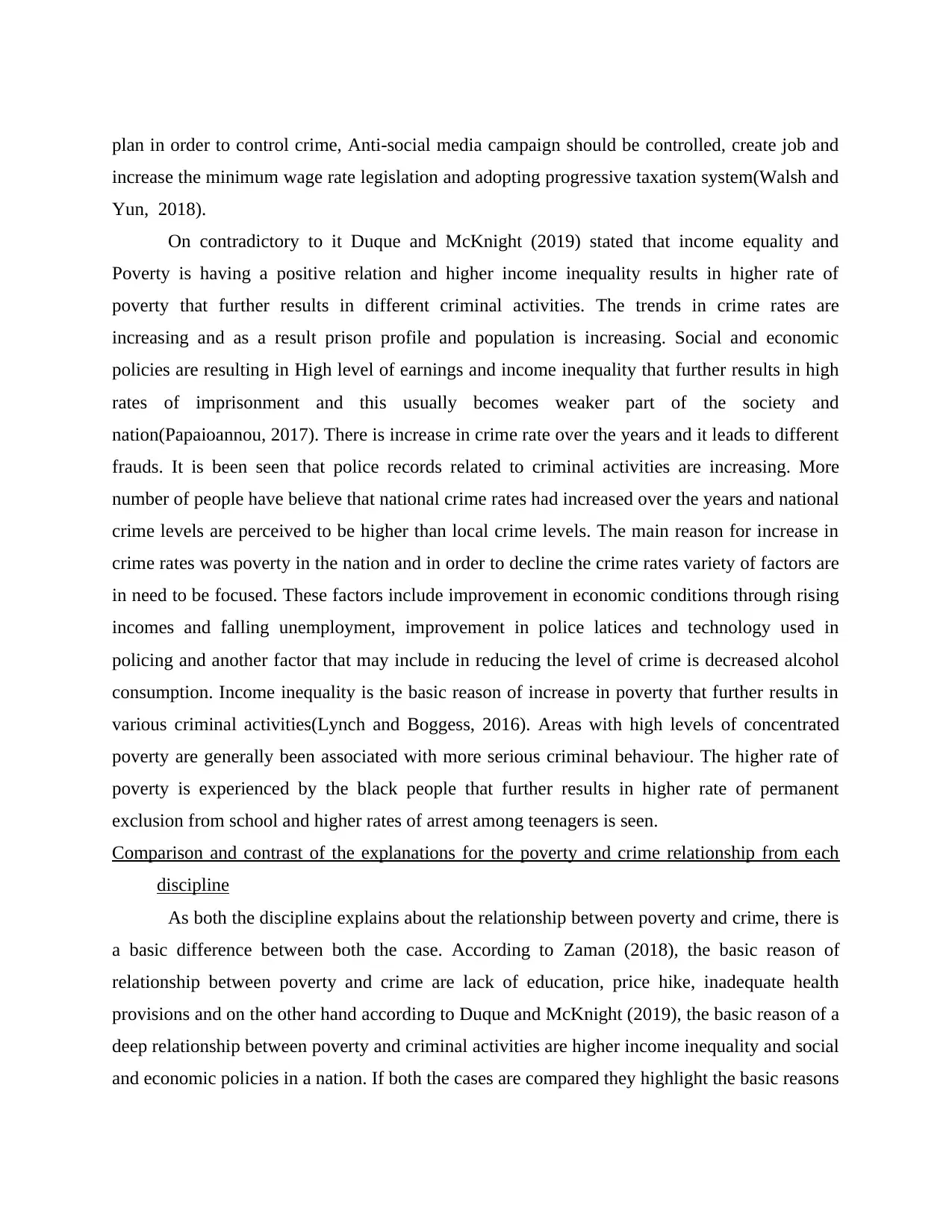
plan in order to control crime, Anti-social media campaign should be controlled, create job and
increase the minimum wage rate legislation and adopting progressive taxation system(Walsh and
Yun, 2018).
On contradictory to it Duque and McKnight (2019) stated that income equality and
Poverty is having a positive relation and higher income inequality results in higher rate of
poverty that further results in different criminal activities. The trends in crime rates are
increasing and as a result prison profile and population is increasing. Social and economic
policies are resulting in High level of earnings and income inequality that further results in high
rates of imprisonment and this usually becomes weaker part of the society and
nation(Papaioannou, 2017). There is increase in crime rate over the years and it leads to different
frauds. It is been seen that police records related to criminal activities are increasing. More
number of people have believe that national crime rates had increased over the years and national
crime levels are perceived to be higher than local crime levels. The main reason for increase in
crime rates was poverty in the nation and in order to decline the crime rates variety of factors are
in need to be focused. These factors include improvement in economic conditions through rising
incomes and falling unemployment, improvement in police latices and technology used in
policing and another factor that may include in reducing the level of crime is decreased alcohol
consumption. Income inequality is the basic reason of increase in poverty that further results in
various criminal activities(Lynch and Boggess, 2016). Areas with high levels of concentrated
poverty are generally been associated with more serious criminal behaviour. The higher rate of
poverty is experienced by the black people that further results in higher rate of permanent
exclusion from school and higher rates of arrest among teenagers is seen.
Comparison and contrast of the explanations for the poverty and crime relationship from each
discipline
As both the discipline explains about the relationship between poverty and crime, there is
a basic difference between both the case. According to Zaman (2018), the basic reason of
relationship between poverty and crime are lack of education, price hike, inadequate health
provisions and on the other hand according to Duque and McKnight (2019), the basic reason of a
deep relationship between poverty and criminal activities are higher income inequality and social
and economic policies in a nation. If both the cases are compared they highlight the basic reasons
increase the minimum wage rate legislation and adopting progressive taxation system(Walsh and
Yun, 2018).
On contradictory to it Duque and McKnight (2019) stated that income equality and
Poverty is having a positive relation and higher income inequality results in higher rate of
poverty that further results in different criminal activities. The trends in crime rates are
increasing and as a result prison profile and population is increasing. Social and economic
policies are resulting in High level of earnings and income inequality that further results in high
rates of imprisonment and this usually becomes weaker part of the society and
nation(Papaioannou, 2017). There is increase in crime rate over the years and it leads to different
frauds. It is been seen that police records related to criminal activities are increasing. More
number of people have believe that national crime rates had increased over the years and national
crime levels are perceived to be higher than local crime levels. The main reason for increase in
crime rates was poverty in the nation and in order to decline the crime rates variety of factors are
in need to be focused. These factors include improvement in economic conditions through rising
incomes and falling unemployment, improvement in police latices and technology used in
policing and another factor that may include in reducing the level of crime is decreased alcohol
consumption. Income inequality is the basic reason of increase in poverty that further results in
various criminal activities(Lynch and Boggess, 2016). Areas with high levels of concentrated
poverty are generally been associated with more serious criminal behaviour. The higher rate of
poverty is experienced by the black people that further results in higher rate of permanent
exclusion from school and higher rates of arrest among teenagers is seen.
Comparison and contrast of the explanations for the poverty and crime relationship from each
discipline
As both the discipline explains about the relationship between poverty and crime, there is
a basic difference between both the case. According to Zaman (2018), the basic reason of
relationship between poverty and crime are lack of education, price hike, inadequate health
provisions and on the other hand according to Duque and McKnight (2019), the basic reason of a
deep relationship between poverty and criminal activities are higher income inequality and social
and economic policies in a nation. If both the cases are compared they highlight the basic reasons
Paraphrase This Document
Need a fresh take? Get an instant paraphrase of this document with our AI Paraphraser
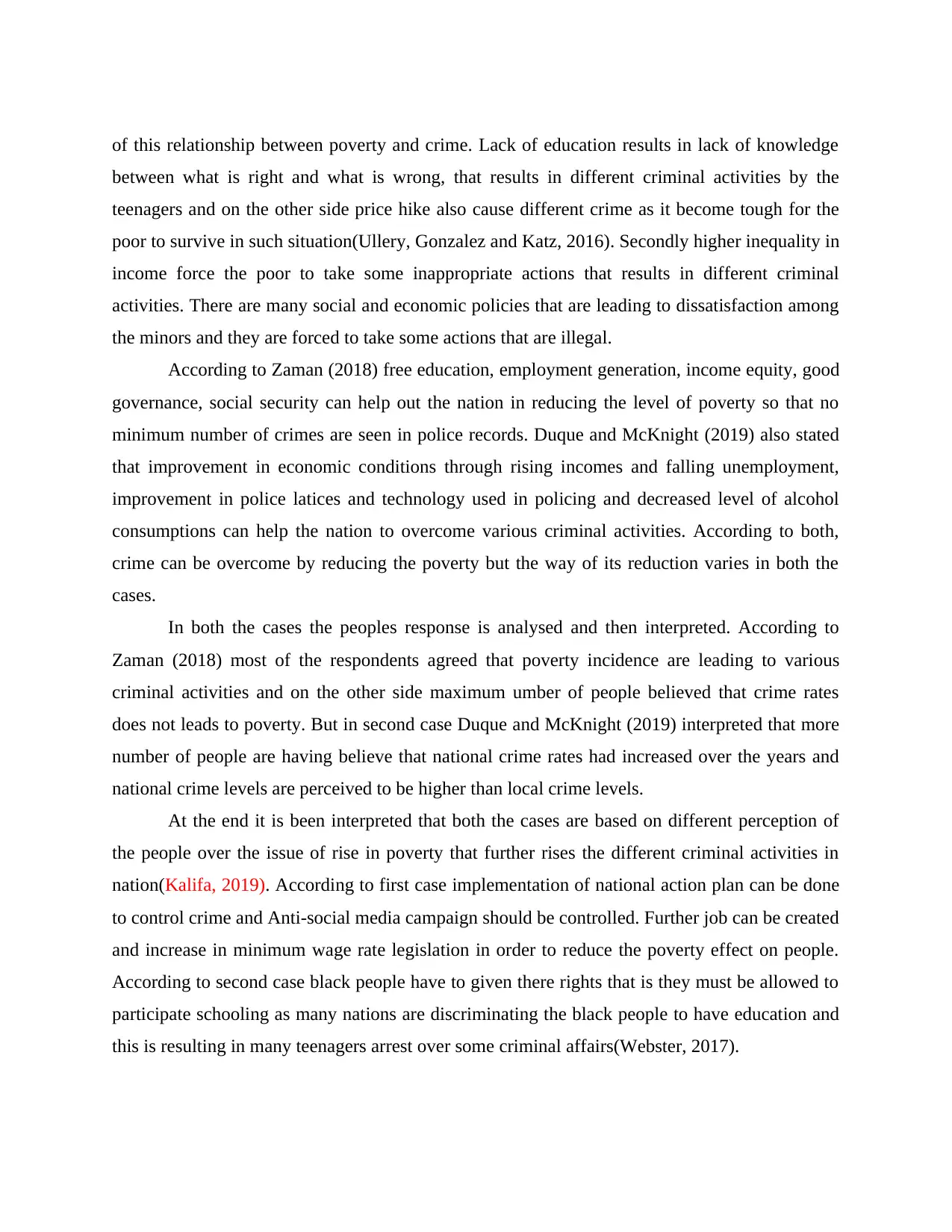
of this relationship between poverty and crime. Lack of education results in lack of knowledge
between what is right and what is wrong, that results in different criminal activities by the
teenagers and on the other side price hike also cause different crime as it become tough for the
poor to survive in such situation(Ullery, Gonzalez and Katz, 2016). Secondly higher inequality in
income force the poor to take some inappropriate actions that results in different criminal
activities. There are many social and economic policies that are leading to dissatisfaction among
the minors and they are forced to take some actions that are illegal.
According to Zaman (2018) free education, employment generation, income equity, good
governance, social security can help out the nation in reducing the level of poverty so that no
minimum number of crimes are seen in police records. Duque and McKnight (2019) also stated
that improvement in economic conditions through rising incomes and falling unemployment,
improvement in police latices and technology used in policing and decreased level of alcohol
consumptions can help the nation to overcome various criminal activities. According to both,
crime can be overcome by reducing the poverty but the way of its reduction varies in both the
cases.
In both the cases the peoples response is analysed and then interpreted. According to
Zaman (2018) most of the respondents agreed that poverty incidence are leading to various
criminal activities and on the other side maximum umber of people believed that crime rates
does not leads to poverty. But in second case Duque and McKnight (2019) interpreted that more
number of people are having believe that national crime rates had increased over the years and
national crime levels are perceived to be higher than local crime levels.
At the end it is been interpreted that both the cases are based on different perception of
the people over the issue of rise in poverty that further rises the different criminal activities in
nation(Kalifa, 2019). According to first case implementation of national action plan can be done
to control crime and Anti-social media campaign should be controlled. Further job can be created
and increase in minimum wage rate legislation in order to reduce the poverty effect on people.
According to second case black people have to given there rights that is they must be allowed to
participate schooling as many nations are discriminating the black people to have education and
this is resulting in many teenagers arrest over some criminal affairs(Webster, 2017).
between what is right and what is wrong, that results in different criminal activities by the
teenagers and on the other side price hike also cause different crime as it become tough for the
poor to survive in such situation(Ullery, Gonzalez and Katz, 2016). Secondly higher inequality in
income force the poor to take some inappropriate actions that results in different criminal
activities. There are many social and economic policies that are leading to dissatisfaction among
the minors and they are forced to take some actions that are illegal.
According to Zaman (2018) free education, employment generation, income equity, good
governance, social security can help out the nation in reducing the level of poverty so that no
minimum number of crimes are seen in police records. Duque and McKnight (2019) also stated
that improvement in economic conditions through rising incomes and falling unemployment,
improvement in police latices and technology used in policing and decreased level of alcohol
consumptions can help the nation to overcome various criminal activities. According to both,
crime can be overcome by reducing the poverty but the way of its reduction varies in both the
cases.
In both the cases the peoples response is analysed and then interpreted. According to
Zaman (2018) most of the respondents agreed that poverty incidence are leading to various
criminal activities and on the other side maximum umber of people believed that crime rates
does not leads to poverty. But in second case Duque and McKnight (2019) interpreted that more
number of people are having believe that national crime rates had increased over the years and
national crime levels are perceived to be higher than local crime levels.
At the end it is been interpreted that both the cases are based on different perception of
the people over the issue of rise in poverty that further rises the different criminal activities in
nation(Kalifa, 2019). According to first case implementation of national action plan can be done
to control crime and Anti-social media campaign should be controlled. Further job can be created
and increase in minimum wage rate legislation in order to reduce the poverty effect on people.
According to second case black people have to given there rights that is they must be allowed to
participate schooling as many nations are discriminating the black people to have education and
this is resulting in many teenagers arrest over some criminal affairs(Webster, 2017).
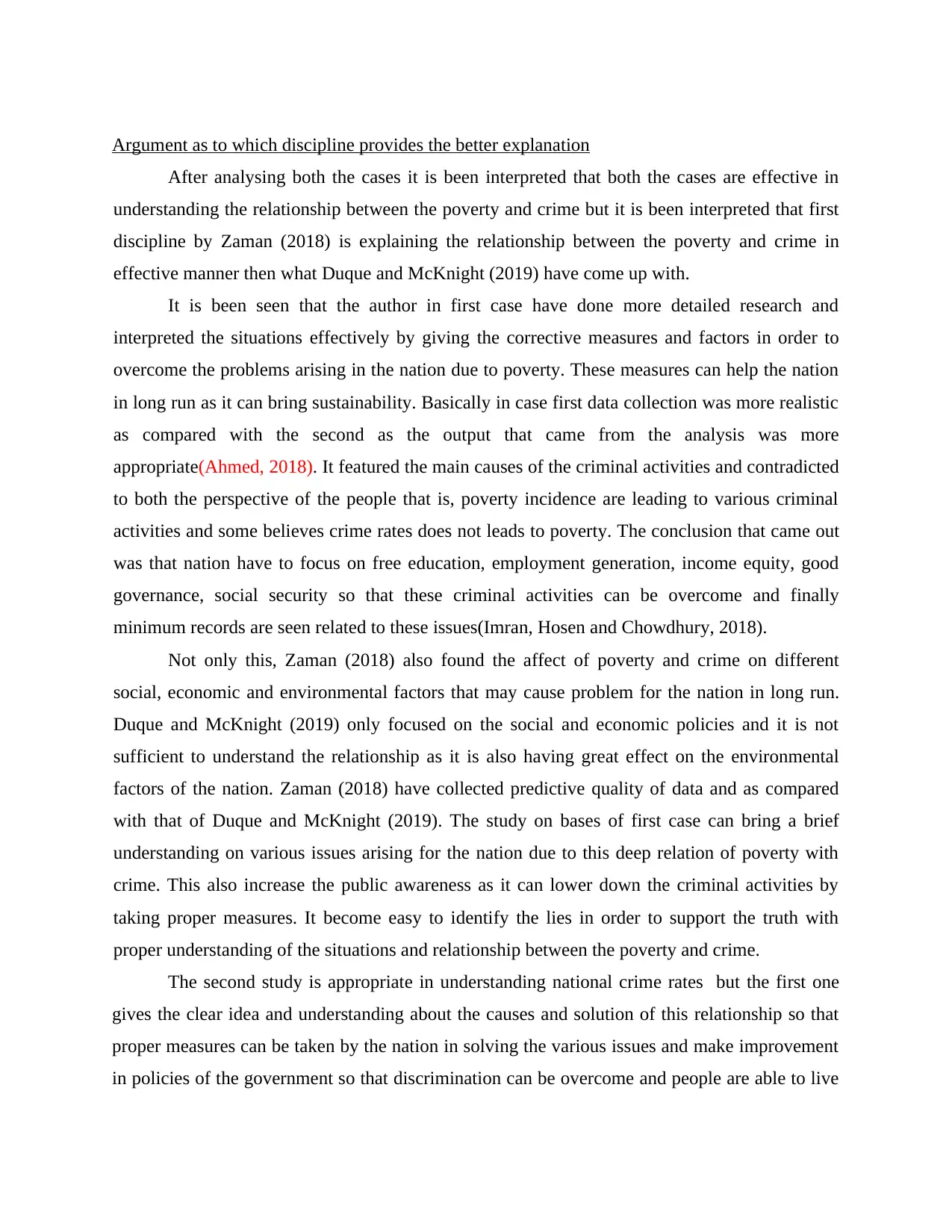
Argument as to which discipline provides the better explanation
After analysing both the cases it is been interpreted that both the cases are effective in
understanding the relationship between the poverty and crime but it is been interpreted that first
discipline by Zaman (2018) is explaining the relationship between the poverty and crime in
effective manner then what Duque and McKnight (2019) have come up with.
It is been seen that the author in first case have done more detailed research and
interpreted the situations effectively by giving the corrective measures and factors in order to
overcome the problems arising in the nation due to poverty. These measures can help the nation
in long run as it can bring sustainability. Basically in case first data collection was more realistic
as compared with the second as the output that came from the analysis was more
appropriate(Ahmed, 2018). It featured the main causes of the criminal activities and contradicted
to both the perspective of the people that is, poverty incidence are leading to various criminal
activities and some believes crime rates does not leads to poverty. The conclusion that came out
was that nation have to focus on free education, employment generation, income equity, good
governance, social security so that these criminal activities can be overcome and finally
minimum records are seen related to these issues(Imran, Hosen and Chowdhury, 2018).
Not only this, Zaman (2018) also found the affect of poverty and crime on different
social, economic and environmental factors that may cause problem for the nation in long run.
Duque and McKnight (2019) only focused on the social and economic policies and it is not
sufficient to understand the relationship as it is also having great effect on the environmental
factors of the nation. Zaman (2018) have collected predictive quality of data and as compared
with that of Duque and McKnight (2019). The study on bases of first case can bring a brief
understanding on various issues arising for the nation due to this deep relation of poverty with
crime. This also increase the public awareness as it can lower down the criminal activities by
taking proper measures. It become easy to identify the lies in order to support the truth with
proper understanding of the situations and relationship between the poverty and crime.
The second study is appropriate in understanding national crime rates but the first one
gives the clear idea and understanding about the causes and solution of this relationship so that
proper measures can be taken by the nation in solving the various issues and make improvement
in policies of the government so that discrimination can be overcome and people are able to live
After analysing both the cases it is been interpreted that both the cases are effective in
understanding the relationship between the poverty and crime but it is been interpreted that first
discipline by Zaman (2018) is explaining the relationship between the poverty and crime in
effective manner then what Duque and McKnight (2019) have come up with.
It is been seen that the author in first case have done more detailed research and
interpreted the situations effectively by giving the corrective measures and factors in order to
overcome the problems arising in the nation due to poverty. These measures can help the nation
in long run as it can bring sustainability. Basically in case first data collection was more realistic
as compared with the second as the output that came from the analysis was more
appropriate(Ahmed, 2018). It featured the main causes of the criminal activities and contradicted
to both the perspective of the people that is, poverty incidence are leading to various criminal
activities and some believes crime rates does not leads to poverty. The conclusion that came out
was that nation have to focus on free education, employment generation, income equity, good
governance, social security so that these criminal activities can be overcome and finally
minimum records are seen related to these issues(Imran, Hosen and Chowdhury, 2018).
Not only this, Zaman (2018) also found the affect of poverty and crime on different
social, economic and environmental factors that may cause problem for the nation in long run.
Duque and McKnight (2019) only focused on the social and economic policies and it is not
sufficient to understand the relationship as it is also having great effect on the environmental
factors of the nation. Zaman (2018) have collected predictive quality of data and as compared
with that of Duque and McKnight (2019). The study on bases of first case can bring a brief
understanding on various issues arising for the nation due to this deep relation of poverty with
crime. This also increase the public awareness as it can lower down the criminal activities by
taking proper measures. It become easy to identify the lies in order to support the truth with
proper understanding of the situations and relationship between the poverty and crime.
The second study is appropriate in understanding national crime rates but the first one
gives the clear idea and understanding about the causes and solution of this relationship so that
proper measures can be taken by the nation in solving the various issues and make improvement
in policies of the government so that discrimination can be overcome and people are able to live
⊘ This is a preview!⊘
Do you want full access?
Subscribe today to unlock all pages.

Trusted by 1+ million students worldwide
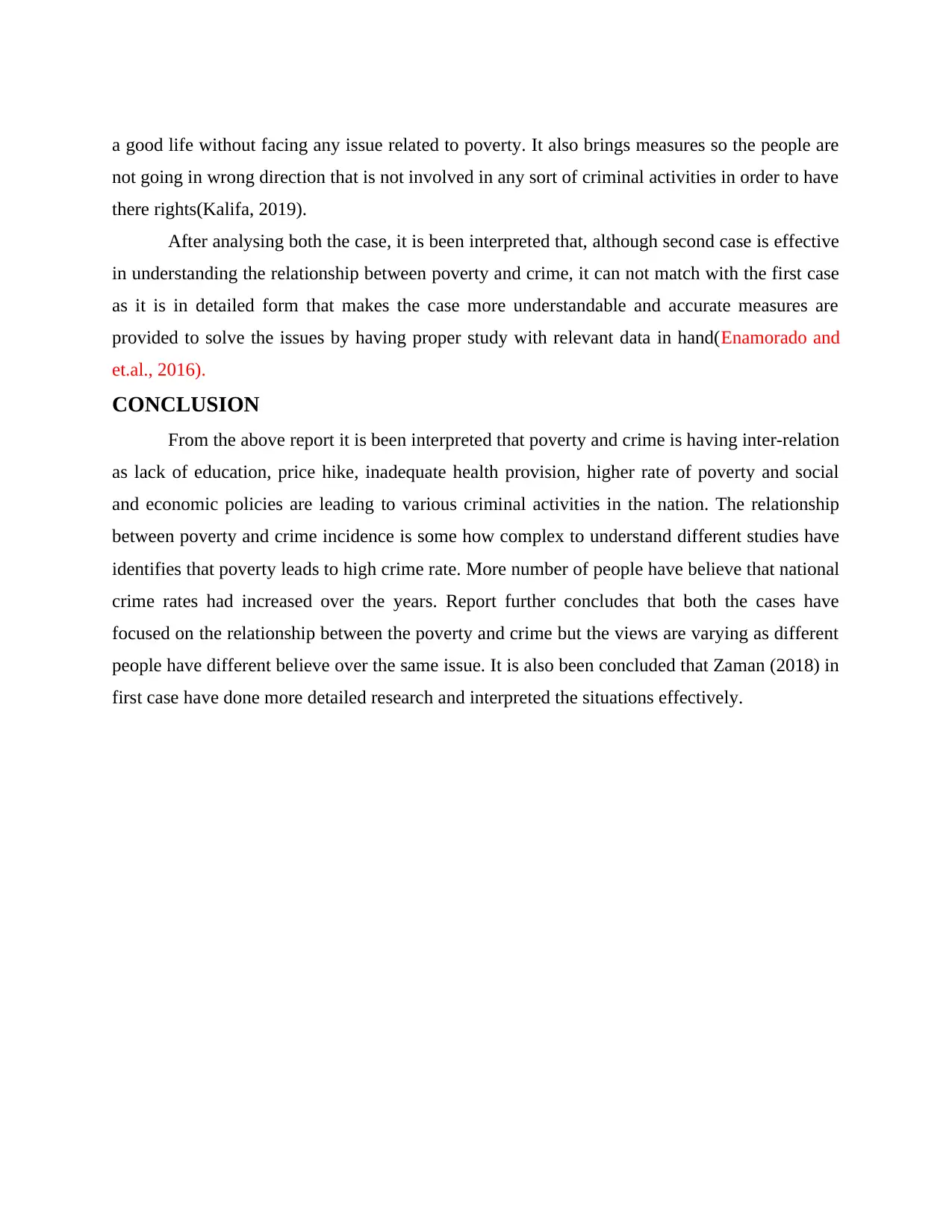
a good life without facing any issue related to poverty. It also brings measures so the people are
not going in wrong direction that is not involved in any sort of criminal activities in order to have
there rights(Kalifa, 2019).
After analysing both the case, it is been interpreted that, although second case is effective
in understanding the relationship between poverty and crime, it can not match with the first case
as it is in detailed form that makes the case more understandable and accurate measures are
provided to solve the issues by having proper study with relevant data in hand(Enamorado and
et.al., 2016).
CONCLUSION
From the above report it is been interpreted that poverty and crime is having inter-relation
as lack of education, price hike, inadequate health provision, higher rate of poverty and social
and economic policies are leading to various criminal activities in the nation. The relationship
between poverty and crime incidence is some how complex to understand different studies have
identifies that poverty leads to high crime rate. More number of people have believe that national
crime rates had increased over the years. Report further concludes that both the cases have
focused on the relationship between the poverty and crime but the views are varying as different
people have different believe over the same issue. It is also been concluded that Zaman (2018) in
first case have done more detailed research and interpreted the situations effectively.
not going in wrong direction that is not involved in any sort of criminal activities in order to have
there rights(Kalifa, 2019).
After analysing both the case, it is been interpreted that, although second case is effective
in understanding the relationship between poverty and crime, it can not match with the first case
as it is in detailed form that makes the case more understandable and accurate measures are
provided to solve the issues by having proper study with relevant data in hand(Enamorado and
et.al., 2016).
CONCLUSION
From the above report it is been interpreted that poverty and crime is having inter-relation
as lack of education, price hike, inadequate health provision, higher rate of poverty and social
and economic policies are leading to various criminal activities in the nation. The relationship
between poverty and crime incidence is some how complex to understand different studies have
identifies that poverty leads to high crime rate. More number of people have believe that national
crime rates had increased over the years. Report further concludes that both the cases have
focused on the relationship between the poverty and crime but the views are varying as different
people have different believe over the same issue. It is also been concluded that Zaman (2018) in
first case have done more detailed research and interpreted the situations effectively.
Paraphrase This Document
Need a fresh take? Get an instant paraphrase of this document with our AI Paraphraser
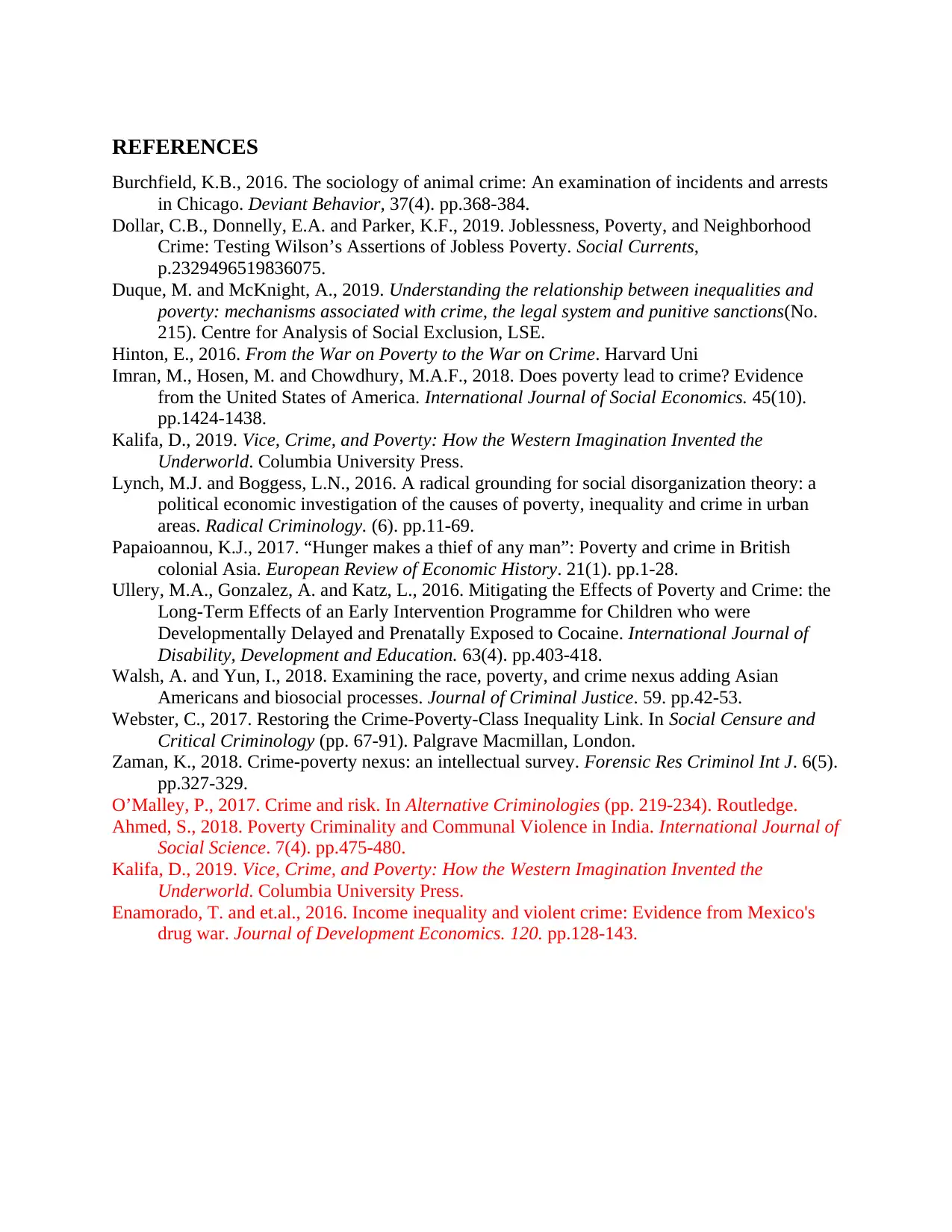
REFERENCES
Burchfield, K.B., 2016. The sociology of animal crime: An examination of incidents and arrests
in Chicago. Deviant Behavior, 37(4). pp.368-384.
Dollar, C.B., Donnelly, E.A. and Parker, K.F., 2019. Joblessness, Poverty, and Neighborhood
Crime: Testing Wilson’s Assertions of Jobless Poverty. Social Currents,
p.2329496519836075.
Duque, M. and McKnight, A., 2019. Understanding the relationship between inequalities and
poverty: mechanisms associated with crime, the legal system and punitive sanctions(No.
215). Centre for Analysis of Social Exclusion, LSE.
Hinton, E., 2016. From the War on Poverty to the War on Crime. Harvard Uni
Imran, M., Hosen, M. and Chowdhury, M.A.F., 2018. Does poverty lead to crime? Evidence
from the United States of America. International Journal of Social Economics. 45(10).
pp.1424-1438.
Kalifa, D., 2019. Vice, Crime, and Poverty: How the Western Imagination Invented the
Underworld. Columbia University Press.
Lynch, M.J. and Boggess, L.N., 2016. A radical grounding for social disorganization theory: a
political economic investigation of the causes of poverty, inequality and crime in urban
areas. Radical Criminology. (6). pp.11-69.
Papaioannou, K.J., 2017. “Hunger makes a thief of any man”: Poverty and crime in British
colonial Asia. European Review of Economic History. 21(1). pp.1-28.
Ullery, M.A., Gonzalez, A. and Katz, L., 2016. Mitigating the Effects of Poverty and Crime: the
Long-Term Effects of an Early Intervention Programme for Children who were
Developmentally Delayed and Prenatally Exposed to Cocaine. International Journal of
Disability, Development and Education. 63(4). pp.403-418.
Walsh, A. and Yun, I., 2018. Examining the race, poverty, and crime nexus adding Asian
Americans and biosocial processes. Journal of Criminal Justice. 59. pp.42-53.
Webster, C., 2017. Restoring the Crime-Poverty-Class Inequality Link. In Social Censure and
Critical Criminology (pp. 67-91). Palgrave Macmillan, London.
Zaman, K., 2018. Crime-poverty nexus: an intellectual survey. Forensic Res Criminol Int J. 6(5).
pp.327-329.
O’Malley, P., 2017. Crime and risk. In Alternative Criminologies (pp. 219-234). Routledge.
Ahmed, S., 2018. Poverty Criminality and Communal Violence in India. International Journal of
Social Science. 7(4). pp.475-480.
Kalifa, D., 2019. Vice, Crime, and Poverty: How the Western Imagination Invented the
Underworld. Columbia University Press.
Enamorado, T. and et.al., 2016. Income inequality and violent crime: Evidence from Mexico's
drug war. Journal of Development Economics. 120. pp.128-143.
Burchfield, K.B., 2016. The sociology of animal crime: An examination of incidents and arrests
in Chicago. Deviant Behavior, 37(4). pp.368-384.
Dollar, C.B., Donnelly, E.A. and Parker, K.F., 2019. Joblessness, Poverty, and Neighborhood
Crime: Testing Wilson’s Assertions of Jobless Poverty. Social Currents,
p.2329496519836075.
Duque, M. and McKnight, A., 2019. Understanding the relationship between inequalities and
poverty: mechanisms associated with crime, the legal system and punitive sanctions(No.
215). Centre for Analysis of Social Exclusion, LSE.
Hinton, E., 2016. From the War on Poverty to the War on Crime. Harvard Uni
Imran, M., Hosen, M. and Chowdhury, M.A.F., 2018. Does poverty lead to crime? Evidence
from the United States of America. International Journal of Social Economics. 45(10).
pp.1424-1438.
Kalifa, D., 2019. Vice, Crime, and Poverty: How the Western Imagination Invented the
Underworld. Columbia University Press.
Lynch, M.J. and Boggess, L.N., 2016. A radical grounding for social disorganization theory: a
political economic investigation of the causes of poverty, inequality and crime in urban
areas. Radical Criminology. (6). pp.11-69.
Papaioannou, K.J., 2017. “Hunger makes a thief of any man”: Poverty and crime in British
colonial Asia. European Review of Economic History. 21(1). pp.1-28.
Ullery, M.A., Gonzalez, A. and Katz, L., 2016. Mitigating the Effects of Poverty and Crime: the
Long-Term Effects of an Early Intervention Programme for Children who were
Developmentally Delayed and Prenatally Exposed to Cocaine. International Journal of
Disability, Development and Education. 63(4). pp.403-418.
Walsh, A. and Yun, I., 2018. Examining the race, poverty, and crime nexus adding Asian
Americans and biosocial processes. Journal of Criminal Justice. 59. pp.42-53.
Webster, C., 2017. Restoring the Crime-Poverty-Class Inequality Link. In Social Censure and
Critical Criminology (pp. 67-91). Palgrave Macmillan, London.
Zaman, K., 2018. Crime-poverty nexus: an intellectual survey. Forensic Res Criminol Int J. 6(5).
pp.327-329.
O’Malley, P., 2017. Crime and risk. In Alternative Criminologies (pp. 219-234). Routledge.
Ahmed, S., 2018. Poverty Criminality and Communal Violence in India. International Journal of
Social Science. 7(4). pp.475-480.
Kalifa, D., 2019. Vice, Crime, and Poverty: How the Western Imagination Invented the
Underworld. Columbia University Press.
Enamorado, T. and et.al., 2016. Income inequality and violent crime: Evidence from Mexico's
drug war. Journal of Development Economics. 120. pp.128-143.
1 out of 8
Related Documents
Your All-in-One AI-Powered Toolkit for Academic Success.
+13062052269
info@desklib.com
Available 24*7 on WhatsApp / Email
![[object Object]](/_next/static/media/star-bottom.7253800d.svg)
Unlock your academic potential
Copyright © 2020–2025 A2Z Services. All Rights Reserved. Developed and managed by ZUCOL.





